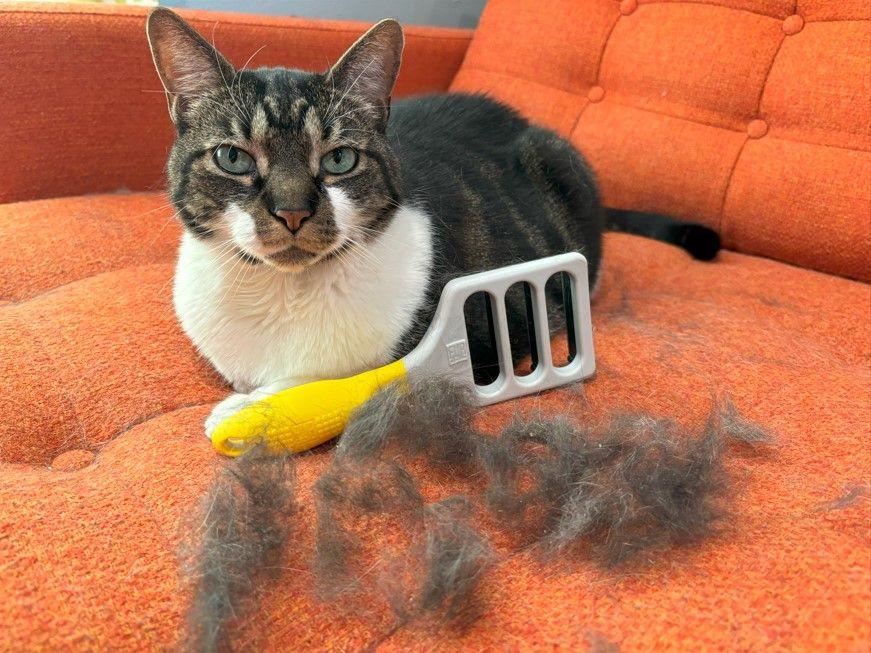How to Eliminate Hairballs Through Cat deShedding with the FUR4 deShedding Tool
As a cat owner, you’ve likely encountered the unpleasant experience of finding hairballs around your home. Hairballs are a common issue, especially for long-haired or thick-coated cats. They form when cats groom themselves and ingest loose fur, which accumulates in their digestive system.
While occasional hairballs are normal, frequent occurrences can cause discomfort for your cat and become a nuisance for you. The good news? Regular deShedding can significantly reduce hairballs.
In this blog post, we’ll explore how using the FUR4 deShedding tool can help eliminate hairballs and keep your cat healthier and happier.
Understanding Hairballs
Hairballs (trichobezoars) form when cats groom themselves and swallow loose fur. While most fur passes through their digestive system, some can accumulate in the stomach, forming hairballs. Cats typically expel hairballs by vomiting, but frequent or large hairballs can lead to digestive issues and discomfort.
Signs of Hairballs
🐾 Coughing & Gagging – Your cat may make retching noises while trying to expel a hairball.
🐾 Vomiting – Hairballs are often expelled through vomiting, which can be distressing for both you and your cat.
🐾 Reduced Appetite – Frequent hairballs can cause a loss of appetite if your cat feels unwell.
🐾 Lethargy – A cat struggling with hairballs may become less active and appear uncomfortable.
How DeShedding Helps Prevent Hairballs
Regular deShedding plays a crucial role in reducing the amount of loose fur your cat ingests during grooming. By effectively removing the undercoat and loose hairs, you minimize the fur that ends up in your cat’s digestive system—reducing hairball formation.
Benefits of DeShedding for Hairball Prevention
✔ Reduces Loose Fur – Removes dead fur before your cat ingests it.
✔ Promotes Healthy Digestion – Less swallowed fur means a healthier digestive system.
✔ Enhances Coat Health – Removes dead fur and allows the skin to breathe.
✔ Improves Comfort – Prevents mats and tangles, making grooming more comfortable for your cat.
Efficient DeShedding with the FUR4 deShedding Tool
The FUR4 deShedding tool is specifically designed to help you effectively manage your cat’s fur while reducing hairballs. Follow these steps for the best results:
1. Preparation
- Ensure your cat is calm and relaxed before deShedding. Choose a quiet time when your cat is most comfortable.
- Check your cat’s coat for tangles or mats. Use a detangling brush to gently remove these before deShedding.
2. Using the FUR4 DeShedding Tool
- Gentle Strokes – Glide the FUR4 tool in the direction of hair growth, starting from the head and working towards the tail.
- Focus on Key Areas – Pay extra attention to areas where loose fur tends to accumulate (neck, back, and hindquarters).
- Use Short, Light Strokes – Apply light pressure to avoid pulling and ensure a comfortable experience.
3. Regular Cleaning
- Clean the FUR4 tool frequently during the session to remove collected fur and maintain effectiveness.
- Dispose of removed fur properly to keep your grooming area clean.
4. Post-DeShedding Care
- Reward Your Cat – Offer a treat or playtime after grooming to build a positive association.
- Monitor Coat & Skin – Watch for any signs of irritation and adjust your routine as needed.
Creating a Regular DeShedding Routine
Consistency is key to effective deShedding and hairball prevention. Establish a routine that works for you and your cat:
✔ Weekly Sessions – Most cats benefit from weekly deShedding, increasing frequency during peak shedding seasons (spring & fall).
✔ Monitor Shedding Patterns – Some cats may require more frequent sessions, especially if prone to hairballs.
✔ Combine with Regular Brushing – Use a bristle or slicker brush alongside deShedding to remove surface debris and maintain coat smoothness.
Additional Tips for Hairball Prevention
1. Provide a Balanced Diet
🥩 A high-fiber diet can help move ingested fur through the digestive system efficiently.
🥣 Consider hairball control cat food or fiber supplements designed to reduce hairball formation.
2. Encourage Hydration
💧 Ensure your cat has fresh water available at all times—hydration aids digestion and helps prevent hairballs.
🥫 Wet cat food can also contribute to your cat’s overall water intake.
3. Maintain a Clean Environment
🧹 Regularly vacuum furniture and carpets to remove loose fur from your home.
🛋 Use a pet hair vacuum to manage shedding effectively.
4. Monitor Your Cat’s Health
⚕ If hairballs become persistent or severe, consult your veterinarian for additional advice or treatment options.
Conclusion
Hairballs can be a nuisance, but regular deShedding with the FUR4 deShedding tool can significantly reduce their occurrence. By removing loose fur before it gets ingested, you’ll help keep your cat’s digestive system healthy and their coat in top condition.
🐾 Establish a deShedding routine, support it with a proper diet and hydration, and enjoy a happier, hairball-free life with your feline friend!
